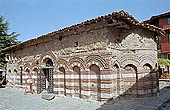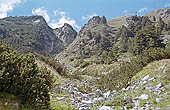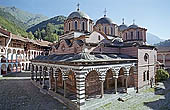Thracian Tomb of Kazanlak
The geographical center of Bulgaria, between the Stara Planina and Sredna Gora mountains,
is known as the Rose Valley. For centuries the fragrant Bulgarian rose has been grown there and attar of roses is extracted. Here, in the town of Kazanluk, a small Thracian Tomb was discovered in 1944., with mural paintings of exceptional interest.
The numerous burial mounds in the Kazanluk area (more than 500), together with the remains of Thracian settlements, including Seuthopolis, the only Thracian city that has been completely excavated, show that the area was inhabited by a large Thracian population, which reached the height of its cultural development during the v - iii centuries B.C.
Thracian Tomb of Kazanlak |

|
Ancient city of Nessebur
In 1983 Nessebur was put on the UNESCO List of World Cultural Monuments. Systematic archaeological studies, and restoration have preserved the material traces of history more than anywhere else. The millennia of uninterrupted human occupation (the earliest traces of human settlement date back to over 3000 years ago) have produced an impressive cultural layer.
Its churches are fine examples of Byzantine architecture.

|
Ancient city of Nessebur
|
Pirin National Park
Difficult to access, but singularly beautiful, the 27,400 hectares of Pirin Mountains Park protects the high elevation areas of Pirin located in the Rila-Rhodopean region in the
South-West Bulgaria.
The Pirin relief was shaped during the Pleistocene when it was subjected to Alpine-like glaciations
that formed its alpine character with about 60 snow-capped peaks rising above 2,500 m. glacial cirques, more than 176 glacier lakes, steep slopes, high ridges and deep river valleys. Its highest point is peak Vihren (2914 m the third highest
of the Balkan Peninsula).
Characterised by the continental Mediterranean climate with frequent and abundant rainfalls, the fame of the Pirin are its forests of black and white fir, covering more than half
of its area.
Pirin National Park |

|
Rila Monastery
Rila Monastery, founded in the x century by the Bulgarian monk St. John of Rila, it was rebuilt in the xiii-xiv century. From that time are the fortress tower (1334), the bishop's throne, richly carved doors and some manuscripts, icons and church plates. The monastery was rebuilt several times and during the Ottoman domination it was a of spiritual and cultural centre for the Bulgarian nation. During the national Renaissance period (xviii – xix c) the complex was reconstructed and renovated. The present-day look dates to the xix c. when the monastery has been thoroughly renovated and the residential wings and the church of the Holy Virgin were built (1834-1837).

|
Rila Monastery
|
|
|
|



